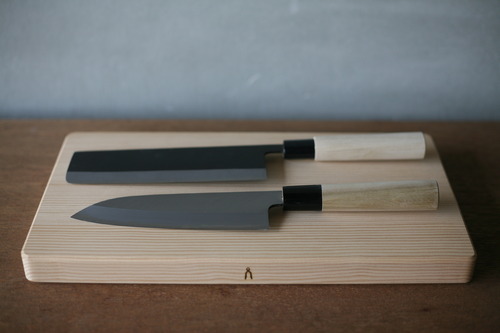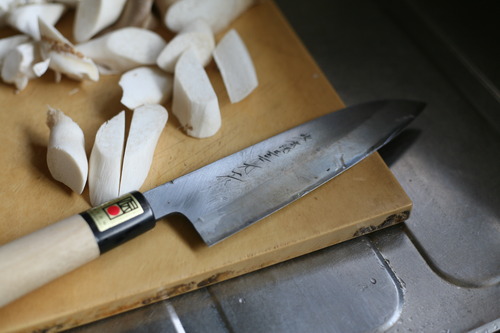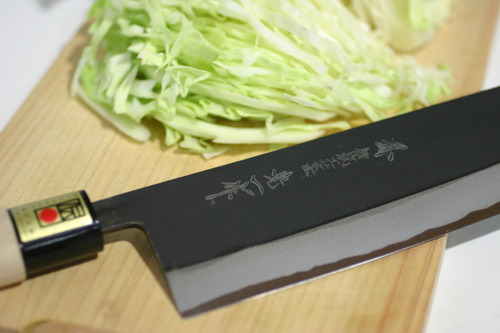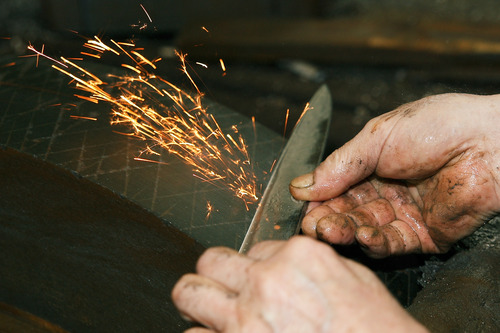



[Sakai Uchihamono and Morimoto Hamono]
Of all the cutlery production areas in Japan, Sakai Uchihamono, made in Sakai City, Osaka Prefecture, is the cutlery favored mainly by professional chefs, and is said to account for nearly 90% of the market share.
The relationship between Sakai and cutlery dates back to the 5th century, when Nintoku-ryo, the world's largest burial mound, was built in Sakai, and craftsmen who made plows and hoes were gathered from all over the country. Craftsmen settled in Sakai and laid the foundation for forging techniques that have continued to the present day.
From the Heian to Kamakura periods, Kawachi founders were active in the manufacture of Buddhist ritual bells and other Buddhist implements, and are said to have participated in the casting of the Great Buddha statues at Todaiji Temple and Kamakura. In the Muromachi period (1333-1573), their skills were transferred to the production of swords and armors.
When guns imported from Portugal were brought to Sakai, the city succeeded in mass-producing them with its superior technology and quickly became famous as a production center of guns. Sakai received strong support from warlords such as Nobunaga Oda, and played an important role in the Warring States Period.
In the Edo period (1603-1867), demand for guns declined, and instead, cigarettes, which were also an imported product, became more popular. In Sakai, too, "tobacco knives" for chopping tobacco leaves began to be made, and this is the origin of today's Sakai Uchihamono.
The Tokugawa Shogunate, recognizing the high quality of these knives, granted the Tokugawa Shogunate the exclusive right to sell them under the "Sakai-kyoku" seal of approval, which led to the spread of Sakaiuchi cutlery throughout Japan. In the middle of the Edo period (1603-1867), Sakai's craftsmen developed kitchen knives such as the de-aberu knife, and it is said that almost all the types of kitchen knives in use today have been produced.
We deal in Bunka Knife and Nanakiri Knife made by Morimoto Hamono, which are Sakai Uchihamono.
Bunka knives, also called santoku knives, can be used for a wide range of foods such as vegetables, fish, and meat, while naikiri knives, as the name suggests, are ideal for chopping and dicing leafy vegetables such as cabbage. The surface of the nakiri knife has a black-plated finish, which makes it resistant to rust. The magnolia wood handle is comfortable to use in the hand, and both knives are double-edged, so they can be used by any dominant hand.
The manufacturing process of Sakai Uchihamono is divided into three parts: forging, sharpening, and handle attachment, and each part is made by a division of labor by craftsmen specializing in each.
Morimoto Hamono is in charge of blade attachment, and each knife forged by a forging craftsman is carefully examined, sharpened, and polished into the shape of a kitchen knife. In the hands of Koichi Morimoto, "Master Craftsman of Naniwa" and "Contemporary Master Craftsman," even the slightest distortion is accurately shaped. The finely sharpened skin of the knife has a beautiful luster peculiar to iron, and the blade pattern, like that of a Japanese sword, has a dignified appearance.
We hope you will use our Sakai Uchihamono knives, which are the culmination of the skills of our craftsmen, and have an outstanding cutting ability.
Morimoto Hamono's Bunka Knife
https://www.shokunin.com/en/morimoto/bunka.html
Morimoto Hamono's Nakiri Knife
https://www.shokunin.com/en/morimoto/nakiri.html
References
http://www.morimotohamono.com
https://ja.wikipedia.org/wiki/堺打刃物
https://ja.wikipedia.org/wiki/河内鋳物師
https://www.sakaihamono.or.jp/hamono02.html